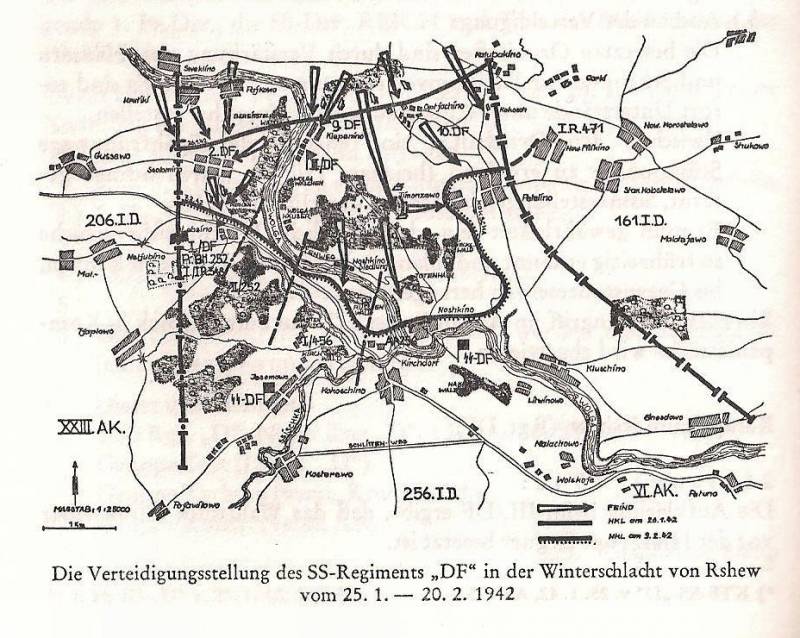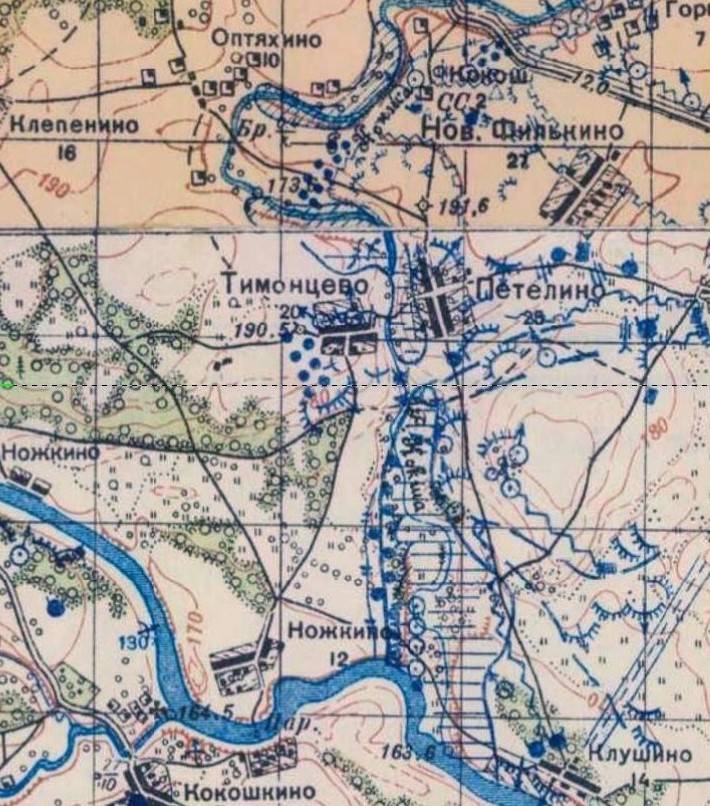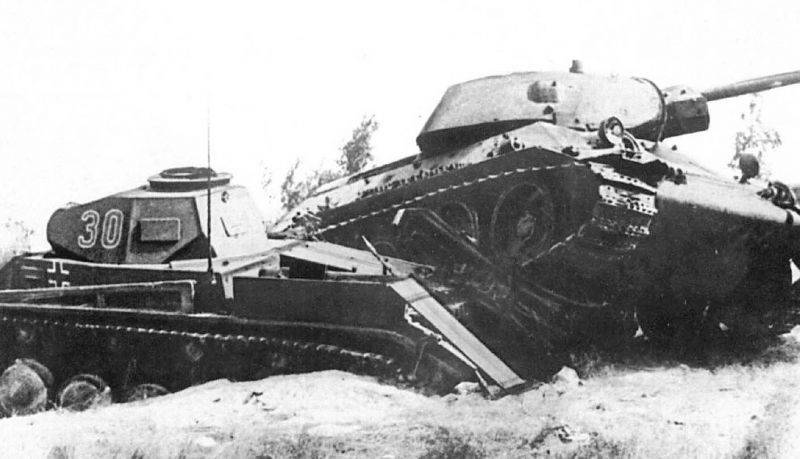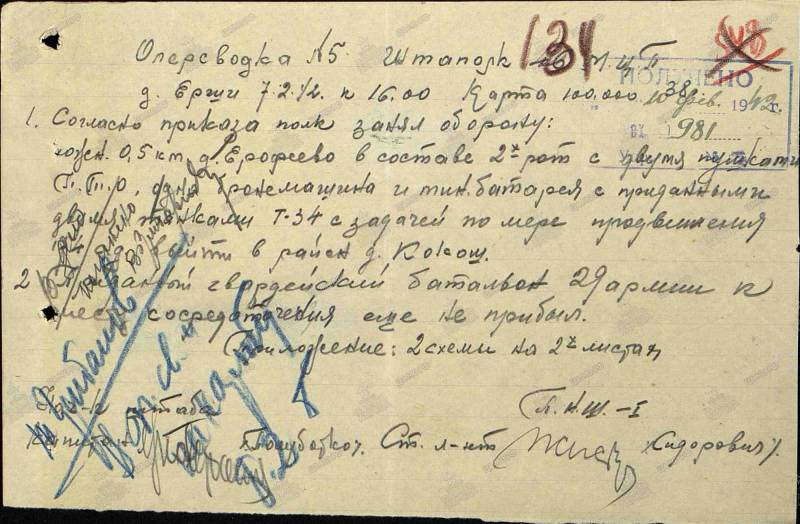The second legendary raid of the tank Stepan Gorobets
On February 8, 1913, Hero of the Soviet Union Stepan Khristoforovich Gorobets was born. On February 8, only in 1942, he died.
First legendary raid tank under the command of Gorobets through Kalinin captured by the Germans is widely known, in Tver there is a monument dedicated to this feat. It was for this raid that S. Gorobets was awarded the Order of the Red Banner by the commander of the 30th Army Khomenko, and Major General Khomenko removed the order from his tunic and handed it to the sergeant immediately after the report of the tankman about the arrival of the units of the 30th Army.
But few people know for what feat S. Gorobets was awarded the title of Hero of the Soviet Union, and there is an explanation for this.
The award presentation for the title of Hero says "... destroyed 12 mortars, 22 machine-gun nests, 3 cannons and 15 dugouts", but even this would not have been enough to receive the title of Hero in early 1942. He received the title of Hero for something else.
I'll try to tell you about it.
prehistory
A successful counteroffensive near Moscow made it possible to push back the Nazi troops from the capital by 150-200 kilometers. Developing the offensive, in January 1942, our 29th and 39th armies broke through the defenses west of Rzhev, crossed the Volga, and the 29th army began to advance east, to Rzhev, and the 39th army, with its offensive in a southerly direction, tried to cut the road Smolensk - Vyazma and join in the Vyazma region with the 33rd Army of the Western Front.
The advanced units of the 29th Army managed to reach almost Rzhev. There were only 8 kilometers to the city.
Hitler changed the command of three armies in this sector of the front, General of the Panzer Troops Walter Model, the future "Fuhrer's firefighter", took command of the 9th Army, who immediately organized a counterattack. The model sent a counterattack to the west, along the Volga, in the direction of Klepenino (left northern bank) and Nelidovo.
The model managed to cut the communications of the broken parts of the 29th and 39th armies.
The armies were not surrounded, but the offensive stalled.
And the Germans urgently transport aviation transferred fresh parts for the defense of Rzhev. The dominance of the Luftwaffe in the air made it possible to quickly restore the defense of the 9th German army.
The Headquarters of the Supreme High Command issues a directive dated January 31 demanding the liquidation of the enemy’s breakthrough along the Volga with the involvement of Lelyushenko’s 30th Army and Stalin’s categorical demand that Konev, commander of the Kalinin Front, be present at the breakthrough site, since to control the troops of the front from the headquarters in Kuvshinovo, and this is 80 kilometers from the front line, it was, according to Stalin, difficult.

Fighting near the villages of Nozhkino and Kokoshkino west of Rzhev in February 1942. German version
Since January 30, the 22th Army has been hastily transferred from the left flank to the right flank of the Kalinin Front.
But how can you hurry, in a snowstorm, off-road?
This army also included the 21st tank brigade, in which Stepan Gorobets served with his crew.
And the Germans had already fortified themselves on the recaptured sector of the front.
Directly at the turn along the left and right banks of the Volga, the SS motorized regiment "Der Fuhrer", reinforced by artillery units and self-propelled guns, took up the defense. Hiding behind this regiment with the units attached to it, or rather, the “Kumm battle group”, named after the commander of the regiment, SS Obersturmbannführer Otto Kumm, the Germans launched attacks on our two armies that were in a semi-encirclement.
The 29th Army was especially hard.
According to our summaries and reports, either to justify it, or from a lack of information, the defense that Lelyushenko's 30th army was supposed to break was occupied by an entire German division. Otherwise, it was impossible to explain the unsuccessful attacks of the army on a sector of only 3 km, even if there were several dozen active bayonets left in the regiments of the army after continuous fighting since the beginning of December 1941.
These days, there was still no question of leaving the semi-encirclement of the 29th Army, the army could retreat to the west, and then to the north, but then the conquered positions were lost to liberate Rzhev, based on this, it was decided to break through a supply corridor, which would be decisive in the successful offensive and encirclement of Army Group Center.
Until the arrival of the 30th Army, these defensive lines tried in vain to break through those formations of the 29th Army, which had unsuccessfully secured the flanks of the advancing armies in their time. For example, in the 915th Rifle Regiment, only 30 active bayonets remained in service, after several attacks on the positions of the 3rd Battalion of the SS Regiment "Der Fuhrer".
But the successful result of this operation to create a supply corridor for the troops of the 29th Army, by coincidence, began to depend, oddly enough, on just one tank - under the number "03", with a crew consisting of commander Stepan Gorobets, driver Litovchenko , charging Kolomiyets and gunner-radio operator Pastushin.
A little more background on the feat of Gorobets.
February 8
The commander-in-chief of the Western direction was G.K. Zhukov, he was appointed by Stalin on February 1 to this position.
The army general arrived at the site of the alleged breakthrough and reported to Stalin the situation on February 3 (remember this date):
Until February 2, Lelyushenko did not organize an offensive, he entered the battle on a wide front, leaving troops in batches on the move without proper artillery support.
As a result, having exhausted the already weak divisions, he was not successful, now the breakthrough is organized by Konev in the main well, with the exception of details that have been corrected on the spot.
Attack result.
By the end of February 3, Lelyushenko defeated the enemy’s SS regiment to a battalion and wedged its defenses for two kilometers, occupying Klepenino and the edge of the forest, which is southeast of Klepenino.
The enemy defends stubbornly in front of Lelyushenko.
Since Army General Zhukov could not check the actual situation on the front line without risking his life, and the constant fire effect did not physically allow this, the report was based on the words of Lelyushenko and Konev, or maybe Zhukov was forced to name the German enemy as an enemy division, and not the SS regiment "Der Fuhrer" with attached units.
In the French company of 1940, it was this regiment that broke the Maginot defensive line, forced Polosukhin's division to retreat on the Borodino field. But his “main achievement” also happened later: in 1944, it was this German unit that “distinguished itself” in France in the village of Oradur (French Khatyn), as they say, left a mark on stories war crimes.
And the battles for Klepenino were still going on at that time.

Reconnaissance map of the summer of 1942
On February 7, 2 T-34 tanks under the command of senior sergeant (in some documents, junior lieutenant) Gorobets and senior lieutenant Smyk were given to reinforce the 46th Moscow Separate Motorcycle Regiment of the operational reserve of the 30th Army.
Transferred to help eliminate the defense center at the height of Kokosh, dominating the corridor along which it was planned to supply the 29th Army and which, so far, was successfully defended by the 10th company of the 3rd battalion of the SS Regiment "Der Fuhrer".
At the height there were well-prepared positions, trenches, dugouts, they were equipped back in September-October 1941 for the defense of Rzhev (pits from dugouts, trenches and a concrete bunker are still preserved). The positions were chosen precisely taking into account the offensive from the western side, and it was from there that our attacks were carried out. In addition, severe frosts further strengthened the soil to the hardness of concrete and turned the height into an almost impregnable fortress.
The lack of shells in the winter of 1941-1942 did not allow us to break dugouts and trenches of a full profile with fire, plus we were still losing in the counter-battery fight.
A stronghold at a height controlled the entire area of combat operations up to the banks of the Volga, and this is about 2,5 km. The height from the west ended with a steep cliff and a bend in the small river Koksha, there was a swampy area impassable for tanks.
The road Rzhev - Selizharovo, passing through a recess in a cliff along the northeastern border of the height, was turned by the Germans into an ice rink, impassable even for infantry. The cliffs along the stream were also a strong obstacle for tanks and infantry.
At the highest point on the height of Kokosh stood a large stone Trinity Cathedral, not yet completely destroyed, and closer to the Selizharovsky tract there was a cemetery (still operating).
There is an interesting document according to which this height was already taken on February 6, based on the combat report of the Chief of Staff of the Kalinin Front dated February 6 to Stalin:
According to the documents, namely: awards, combat reports, orders, as well as reports on the losses of the units that took part in the assault on this height, it was actually taken only on the morning of February 8.
And we can say that it was taken only thanks to the already more fleeting, but no less heroic, raid of the tank number 03 on the "height with the church", as we and the Germans called it.
In fact, having reported to Stalin in advance about the capture of the Kokosh height, both Konev and Lelyushenko were confident that the motorcycle regiment, reinforced with tanks of the 21st TBR under the command of senior sergeant S. Kh. Gorobets and senior lieutenant A. G. Smyk, would take the height.
All participants in the future assault on the German defense stronghold had serious combat experience.
The backbone of the personnel of the 46th separate motorcycle regiment, formed in September in Moscow, consisted of fighters who not only served military service, but also had the experience of Khalkhin Gol and Finnish, there were even border guards who met the war on the western borders and left the encirclement, it can be said that the 46th MCP was an elite unit.
Almost all departments were commanded by foremen.
The commander of the 46th MCP (already the third commander, the previous two Fedorchenko and Milenkih died in fierce battles) Fedor Kharitonovich Polevoy managed to fight in the Civil War, before the war he served with Dovator in the 1st Special Cavalry Regiment (this Kremlin regiment participated in the filming of the legendary film " Alexander Nevsky"), and met the war with the commander of the 11th MCP of the 21st mechanized corps Lelyushenko, this mechanized corps detained Manstein's 56th motorized corps in the battles near Daugavpils in June 1941.
It was at the position of the 11th motorcycle regiment under the command of Lieutenant Colonel Polevoy that Gorobets led his tank out of the raid on the captured Kalinin, exchanging "friendly" shots.
This is how the unit of senior lieutenant Ivan Adamovich Sidorovich met him at first inhospitably, and the document of the 46th regiment, shown above, by the way, was compiled by Sidorovich.
After the disbandment of the 11th MCP, Sidorovich continued to serve in the 46th MCP, and F.Kh.
The 46th motorcycle regiment is the operational reserve of the commander of the 30th army, Lelyushenko. “The best regiment of the army” - this is how it will be written in the award list for the regiment commissar.
The regiment was well armed, back in August-September 1941, when it was formed in Moscow, it was fully equipped with PPSh machine guns. The regiment (4-company, by analogy with the cavalry regiments of the 4-squadron) participated in heavy battles as part of the Vatutin task force, and then in the defense of Kalinin (at the exit from Kalinin, there is a monument tank on a pedestal, on a memorial plaque in the list of units, who stopped the enemy at this line, this regiment is also mentioned).
The regiment especially distinguished itself in the area of Spas-Zaulka on the Leningrad Highway, where it stopped the breakthrough of 55 enemy tanks, as well as in the Klin area, cutting off the Vysokovsk-Klin highway. The destroyed German equipment on this highway was then shown to the diplomats of the allied embassies.
In the conditions of shell hunger in the winter of 1941–1942, during the counteroffensive near Moscow, the regiment used the tactics of night attacks: without artillery preparation, in conditions of limited visibility, at night they crawled unnoticed, without shots, to German positions and broke into the trenches with a short throw, destroying the enemy, fortunately PPSh assault rifles were very effective in trench battles.
Maybe someone remembers the episode of the film “Battle for Moscow”, where Lelyushenko, played by Gennady Saifullin, explains this tactic with the direction of the attack on two fires located in the rear.
And now a document from the 46th ICP signed Art. Lieutenant Sidorovich, the same one whose guns fired at the Gorobets tank at the end of the Kalinin raid: the tank rushed to the Sidorovich battery from the Germans:
Ershi village 7.2.42 to 16:00 Card 100
1. According to the order, the regiment took up defense:
south of 0,5 km of the village of Erofeevo, consisting of 2 companies with two anti-tank guns, one armored vehicle, a minbattery and attached two T-34 tanks with the task of reaching the area of the village of Kokosh as the 174th rifle division advances.
2. The attached Guards Battalion of the 29th Army has not yet arrived at the place of concentration.
Application 2 diagrams on 2 sheets.
Beginning headquarters sl. n. sh.-I
Captain Polubotko St. l-nt Sidorovich
From the order of the commander of the 30th Army Lelyushenko to the commander of the 46th MCP:
The plan developed by the commander of the 46th MCP, and maybe Konev and Lelyushenko, was as follows:
Two tanks produce harassing fire at night from the north-west, constantly moving along the border of the height in a heavy snowstorm and dueling with the anti-tank guns of the 10th company of the SS regiment.
Meanwhile, 2 companies of submachine gunners of the 46th regiment in the dark, in conditions of poor visibility, should crawl as close as possible to the German trenches from the western swampy side, where there was only combat guards, most of the personnel of the SS company will be in dugouts, fleeing the cold , mortar fire and shelling by tanks.
Then one tank should break into the high ground from the northeast and divert all attention and fire on itself.
At this time, two companies of submachine gunners at close range from the opposite side break into the trenches of the enemy, distracted by the bursting Soviet tank, and block the dugouts.
It remains to choose the one who can first of all climb a steep icy slope in a tank, filled in advance by the Germans, and then expose himself to fire at close range - literally 200 meters from the road to the center of the German positions.
Now we will never know how they discussed it, how they ordered it, although it is difficult to order in this case, if the tank does not drive in, there is a reason - well, if he couldn’t, then no order will help.
Alexander Matrosov accomplished his great feat due to changed circumstances, saving his brother-soldiers, here the crew of Gorobets knew in advance that he should call all the enemy’s fire on himself.
Senior Lieutenant Smyk, commander of a tank company of the 21st TBR, died early in the morning on February 8.
The book “Brighter than Legends” about the Kalinin raid of Gorobets describes the death of Smyk at the time of the transfer of the order to the Gorobets tank from a mine fragment on the morning of February 8, there are documents on the website “Memory of the People” about the death, but there is also an award for the Order of Lenin dated September 23, 1942 , where it is attributed in other ink "Currently Smyk is in the unit."
Perhaps a re-submission, but posthumously then reluctantly awarded.
According to TsAMO documents, Aleksey Gordeevich Smyk died on February 3, the book also contains the date of death on February 3.
At 7:30 on February 8, Stepan Gorobets' tank on the left flank, under the cover of darkness and snowstorms, bypassed the height from the north, the tank with the crew of the deceased Lieutenant Smyk remained in front of the northwestern side of the height, continuing to conduct distracting fire.
Tank number 03, with a sudden maneuver from the north, drives up the icy road, probably on the tracks there were special holds for winter conditions, which were equipped with T-34s, to a height near the cemetery and advances into the center of the German positions, taking all the fire on itself.
From the book by P. Ivanov and S. Fliegelman "Brighter than Legends":
In the ensuing turmoil, and the tank drove almost into the center of the SS stronghold, unnoticed and closely approached companies of the motorcycle regiment from the opposite side break into the height, destroy the outposts in the trenches, gun crews, machine-gun points and block the dugouts, throwing grenades at them.
From the report on the combat operations of the 21st TBR for the period from 5.02.1942/15.02.1942/XNUMX to XNUMX/XNUMX/XNUMX:
The task of the tanks was the following: together with the artillery of the regiment, fire at the nodes of enemy resistance (a height with a church near the villages of Novoye Filkino and Petelino).
Tanks from 16:00 to 7:00 on February 8.02.42, XNUMX also fired at the enemy at night, using the illumination of enemy missiles. The terrain in the defense area was open, rugged, and allowed direct fire.
Enemy, up to 2 infantry battalions, reinforced art. mortar. units and tanks, stubbornly defended the height with the church near the village of N. Filkino, Timontsevo and Petelino.
Battalion commander 46 mtsp at 7:30 set the task: the crew of ml. lieutenant Gorobets to master the height with the church, the second crew - lieutenant. Smyk - to support the attack of the first crew and the advance of the infantry with fire from the spot.
The task was completed.
Tank tov. Gorobetsa maneuvered from behind the left flank to the church and began to crush with caterpillars and shoot infantry at close range, the enemy infantry fled to N. Filkino and Petelino.
The enemy infantry, being in a hopeless situation (the escape routes were cut off by the tank), returned back to the dugouts), but our infantry arrived in time to destroy the Nazis hiding in the dugouts.
Comrade Gorobets' tank destroyed up to 50 soldiers and officers, up to 12 enemy firing points.
Gorobets' tank received 3 holes: two in the turret, one in the ammo rack.
Tank Commander Jr. lieutenant Gorobets was killed, the turret gunner and radio operator were wounded, mech / water comrade. Litovchenko was shell-shocked, but managed to help the wounded and took the tank out of the battle under its own power ... "
Already ml. Lieutenant S. Kh. Gorobets was posthumously awarded the title of Hero of the Soviet Union, and his crew members, driver Fyodor Litovchenko, gunner-radio operator Ivan Pastushin and loader Nikolai Kapelyushin were awarded the Orders of Lenin.
In the 46th motorcycle regiment on February 8, that is, during the assault, the company commander, Lieutenant Andrei Grigoryevich Krayushin, and 5 Red Army soldiers died.
The commander of the 46th ICP, Lieutenant Colonel F.Kh.
An interesting fact - Paul Karel (real name Paul Schmidt, former press officer of Ribentrop) in his very popular book "Hitler Goes East" spoke very "picturesquely" about the destruction of the 10th company of the Der Fuhrer regiment:
- Hauptsturmführer, I am the only one left alive from my company. All died.
Wagner began to convulse, and in a second the 10th company finally ceased to exist.
But there were only two tanks, not thirty, but what people were in them!
Later, the Germans counterattacked the height from Novy Filkino. Fierce battles unfolded for this height. After February 20 and a partial exit from the encirclement of the 29th Army, the height was abandoned.
Being at the solemn laying of the Rzhev memorial, I asked one search engine about the results of the excavations at the height of Kokosh.
He said that there is solid metal, the metal detector rings constantly, and the probe also constantly sticks into the iron. This is not surprising, the front line passed in this place for a whole year.
Finale
From the memoirs of Elena Rzhevskaya (translator of the headquarters of the 30th Army), the future writer, the widow of the poet Pavel Kogan, who composed the famous song "Brigantines" ("Tired of talking and arguing, and loving tired eyes ...") and "... since childhood I did not like the oval. I have been drawing a corner since childhood...”, who died as part of a reconnaissance group near Novorossiysk, also a translator:
The divisions of his army, which sometimes still threw up reserves, these days were drawn into fierce battles for the villages on both sides of the Volga, in a number of areas they achieved some success - they moved forward, they fought to the death for each village. The most famous are the bloody battles for the villages of Nozhkino and Kokoshkino, whose names in the military reports of units of both warring parties constantly sounded side by side for almost the entire 1942.
Here, the small river Sishka flows into the Volga, the banks of which are repeatedly watered with soldiers' blood.
After the war, E. Rzhevskaya wrote: “... Kokoshkino. But ... while the front was passing here, it sounded only in tandem with Nozhkino - two inseparably neighboring villages, a single springboard for the fiercest bloody battles ... Here, on the ice of both connected rivers, chains of fighters were falling, marching into a mortal battle for this height, under enemy fire , and the one who grabbed the bars already on the other side, rolled down dead onto the ice. When the ice broke, he dragged only a few downstream on his last journey, countless multitudes went under the ice, heavily overloading the river, preventing its course. The river could not accept everyone, overflowed its banks.
At this point on the earth, more bitterly than anywhere else, you feel the inevitability of loss and that you yourself are still alive in this wonderful world, where ... Sishka ends his journey on the run, falling into the Volga. Is it really here that people fought mercilessly, people bled? It was Nozhkino - Kokoshkino - the most disturbing sector of the front ... "


Information